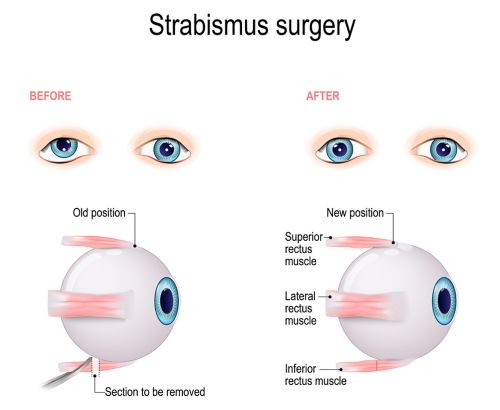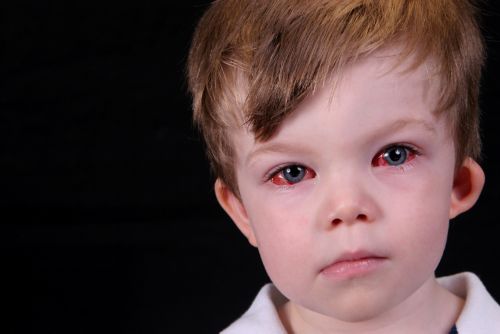Strabismus (Crossed Eyes, Squint)
Strabismus (crossed eyes, squint) is an eye problem where both eyes do not look in the same direction at the same time. Your child’s health care team might say the eyes are “out of alignment” or “misaligned.” One or both eyes may turn out, in, up, or down.
Your child may have a problem with:
- Muscles that move the eye
- Nerves that help the muscles move
- Part of the brain that helps the eyes move
Rarely, strabismus may be caused by a genetic disorder or other medical condition. These include:
The doctor may order one or more of these treatments to help your child:
- Glasses
- Prism lenses to make the light go into the eye easier
- Eye patches
- Eye exercises
- Drops that make the vision blurry in 1 eye
- Shots to help relax the eye muscles
If these treatments do not work, your child might need surgery on their eye muscles. They might need surgery on both eyes, even if only 1 eye looks in the “wrong” direction. Strabismus surgery helps to align the eyes so that they work together.
How to prepare for strabismus surgery
Before the procedure, medical staff will explain what to expect and answer any questions. Always follow the instructions given by your care team.
- Talk to your child about the surgery, and how it will help their eyes.
- Give medicines as instructed.
- Know when your child should stop eating and drinking before surgery.
- Follow instructions about bathing your child before surgery.
- Do not allow your child to wear contact lenses.
What to expect during strabismus surgery
Strabismus surgery takes 2 hours or less. Your child will get general anesthesia. Most patients do not need to stay in the hospital overnight.
During the surgery, the surgeon will use a device to hold the eye open. They will make a small opening through the eye’s surface. The surgeon will detach the eye muscle and reposition it so that the eye goes into the correct, aligned position. Stitches will hold the eye muscles in place in the new position. The stitches will not need to be removed. They will dissolve on their own. The surgeon does not remove the eye during the surgery.
What to expect after strabismus surgery
Your child’s doctor will give you antibiotic drops to put in your child’s eye after surgery. This medicine helps prevent infections. Be sure to follow the directions and use the right number of drops at the right time.
Your child’s eyes might look in the same direction and appear “aligned” right after surgery, or they might not. The eyes will look red and a bit swollen. They might get straighter within 1 or 2 days after surgery, but you might not be able to see it yet. Bruising and swelling may make it hard to tell how straight they are. Your child’s eyes might look straighter as they heal. It takes 4–6 weeks to know if the surgery was effective.
Short-term side-effects after surgery:
- Redness: Your child’s eye will look bright red. This happens because the front of the eye is clear. After surgery, you can see any blood that is present. The redness might last a week before it starts to change. It can take 1–2 months before the eye looks completely white again.
- Color of tears: Your child’s tears may look slightly red from blood. This red color does not mean that your child has an injury. The eye has many blood vessels, and the redness usually goes away in a few hours.
- Double vision: Your child may “see double” after surgery. This double vision can take a few days to several weeks to go away.
- Eye mucus: Your child’s eyes will be sticky with mucus for a few days. The eyelids might stick together at times. Gently wipe the mucus away with a clean, damp washcloth. Do not rub the eye or get water in it.
- Discomfort: Your child’s eye will be sore or feel scratchy after surgery and might be sensitive to light. Pain usually gets better after a few days.
- Infection: Watch your child for any sign of infection and call your doctor if you notice any symptoms of infection.
Pain after surgery
Acetaminophen or ibuprofen are usually enough to stop pain after strabismus surgery.
A cold pack can help control pain, reduce swelling, and keep your child more comfortable. You can use one of the following:
- An ice pack
- A clean washcloth soaked in ice water and wrung out well
- A bag of frozen peas
Wrap the ice pack or bag of frozen peas in a clean washcloth before putting it on your child’s eye. Do not leave the ice pack on for more than 10 minutes. It can be applied again in 1 hour. Follow the directions of your care team.
Possible risks of strabismus surgery
Strabismus surgery is generally safe, but there are risks with any surgery. Risks or possible complications include:
- Risks related to anesthesia
- Vision problems or vision loss
- Bleeding
- Scarring or damage to the eye
- Drooping eyelid
- Infection
In some cases, surgery is not effective, and a second surgery may be needed.
Care after strabismus surgery
Usually, your child can return to normal activities in 1–5 days.
Your care team will give instructions for home care after surgery. For 2 weeks after surgery, your child should avoid:
- Getting water, soap, or shampoo in their eyes
- Rubbing their eyes
- Vigorous activities or rough play such as running, wrestling, playing tag, sports, or other active games
- Swimming
- Excessive screen time from video games, computers, or TV
Returning to school
Although it is different for every child, most children can go back to school in 2–3 days, as long as they are recovering well and do not have double vision.
Avoid activities such as recess, gym, or PE class for 2 weeks after surgery.
Your child’s doctor might also ask your child to limit school or other activities so that they can heal. Always follow the instructions of your child’s care team.
When to call your care team
Infection after strabismus surgery is rare. Even with the use of antibiotic eyedrops, an infection could happen.
Call your doctor or clinic if:
- Eye swelling gets worse
- The eye or eyelid becomes red
- Pus comes from the eye
- They have a fever, as defined by your doctor
- Pain gets worse or does not improve after several days
Key points about strabismus
- Strabismus (crossed eyes) is an eye problem where both eyes do not look in the same direction.
- If other treatments do not work, your child may need strabismus surgery to correct the problem.
- Strabismus surgery adjusts the eye muscles to align the eye.
- Follow your care team’s instructions after strabismus surgery.
-
Retinoblastoma
Retinoblastoma is a cancer of the eye. It most often occurs in young children, usually before 3 years of age. Retinoblastoma forms in the retina of the eye.
-
Diffuse Intrinsic Pontine Glioma (DIPG)
DIPG is a fast-growing brain tumor that begins in an area of the brainstem called the pons. Learn about DIPG symptoms, diagnosis, treatment, and prognosis.
-
Optic Pathway Glioma
Optic pathway glioma (OPG) is a term used for tumors that develop in brain regions involved in vision. Learn about symptoms, diagnosis, and treatment for OPG.


